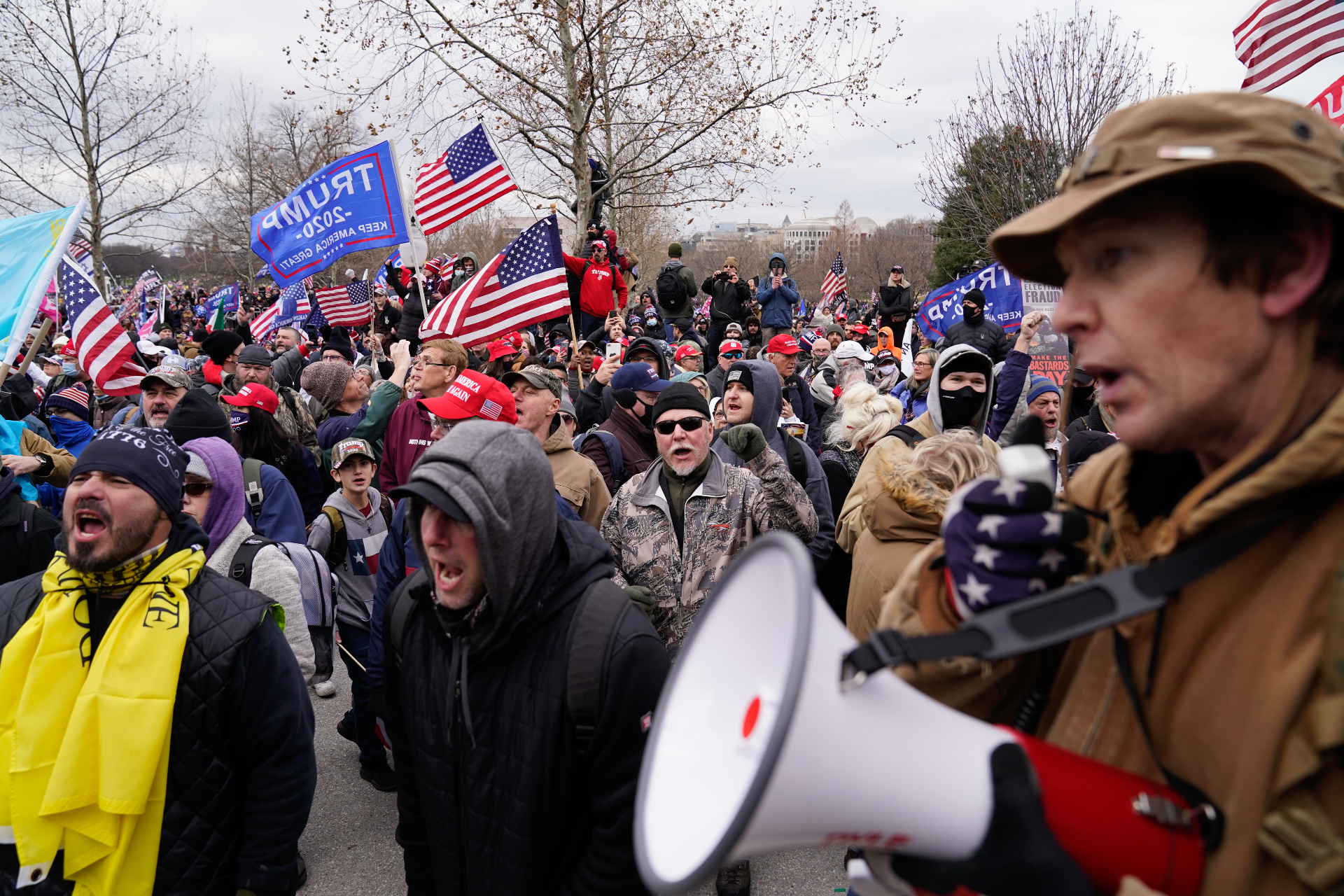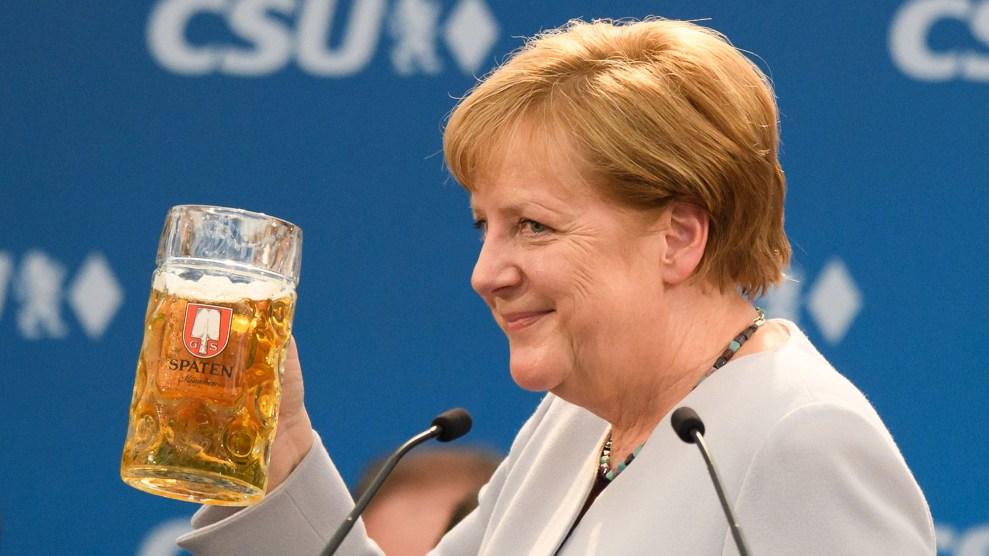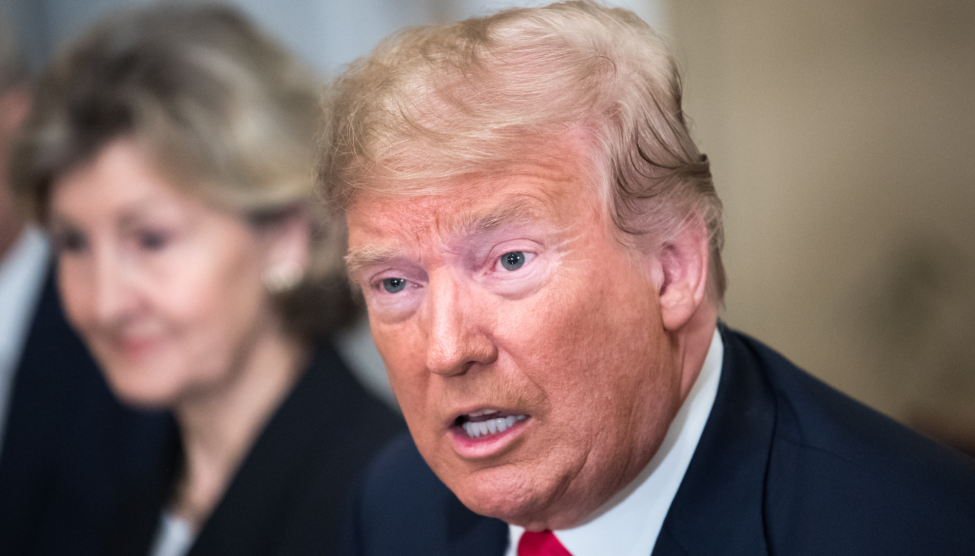In 1954, Eugen Kogon worried that the “the silent gradual, creeping, unstoppable return” of the ex-Nazis seemed to be the “fate” of Germany’s new democracy. Kogon, a Christian socialist intellectual who had been imprisoned in concentration camps, was not alone in his concern. For years after the 1949 founding of West Germany, liberal-minded Germans worried the transition to democracy would end with a rebound to authoritarianism. No one would ever think it’s easy, making the transition from dictatorship to democracy. Especially when the dictatorship has been a particularly brutal and murderous one. But for Kogon, and others yearning for democracy, a basic problem presented itself. What do you do with the people who ran the old regime? And what do you do with the masses of the old regime’s followers? Aren’t they all waiting for restoration—and maybe not just waiting, but actively working toward it?
At the end of the Trump era, we face a similar question. Trump’s post-election attempt to subvert democracy was no surprise. And the raiding of the Capitol was the sort of uncomfortable shock we knew might occur. It was, as I’ve written, our Beer Hall Putsch. This makes aggressive punishments for those involved an obvious need. If we do not do this, our democracy could spiral into dictatorship. Especially insidious has been the Republican Party’s reluctance to stop Trump, even after this attempted coup. Hundreds of Congress members still voted to overturn the election and against impeaching the insurrectionist-in-chief. The lesson is clear: One political party is committed to authoritarianism. We need a harsh reckoning now with those who directly supported the coup attempt.
But, as we look beyond this, there is still a broader issue: the willingness of Trump’s 70 million voters to believe the whole charade up to this point. And, if polls are to be believed, even after the events of January 6. What about the voters who actively supported all this? What do we do with the aides, lackeys, flacks, and bureaucrats who helped his administration violate the norms of our democracy and bring myriad forms of grief to countless Americans? What about those who felt comfortable looking the other way while pocketing their tax cut? Comparisons between Trump’s regime and Weimar Germany, or Nazi Germany, have been done many times during his reign. Of course, the comparison is partial—Trump the person is a very long way from being Adolf Hitler 2.0. But if Germany’s pre-Nazi regime provides a lesson on how to counter a putsch, post–World War II experience also provides a lesson, on how to recover a democracy.
Kogon thought the return of the Nazis—back into the courts, the schools, the upper reaches of government—was going to be a “fatal” blow to democracy. The funny thing is some of the ex-Nazis Kogon feared so much actually agreed with him. One of them was Rudolf Diels, who had been the first chief of Hitler’s Gestapo. In the same year as Kogon’s lament, Diels complained about people who called him “a top Nazi” when “I only worry that they are coming again” and, when they return, “they will not start again at ‘33 but at ‘45”—meaning with the full, brutal radicalism of the end-stage Nazi regime.
Propaganda, then as now, was also a problem. An American diplomat reported in 1954 on the “loss of public confidence in leading Berlin officials, connected with internal political attacks and external propaganda directed to [the] unreliability [of] West German leadership generally.”
And yet we know that somehow democracy prevailed. The 1950s became known in West Germany as the age of the “economic miracle.” The parties of the democratic center extended their reach. The political extremes of left and right melted away. The country joined all the military, political and economic organizations of the democratic West. Gradually it became indispensable to all of them. In the 1970s a stronger democracy could fend off the challenge of domestic terrorism. In 1989–1990, the eastern Communist twin collapsed and Germany was triumphantly reunited. Since 2015, the rise of the Alternative for Germany Party (AfD) and neo-Nazi activists in the Germany army and security forces has drawn media attention. But we need to remember that support for the far right is heavily concentrated in the former East Germany, more a legacy of the Communist German Democratic Republic. In recent years, global surveys have routinely found Germany to be the most admired country in the world.
In 1949 these later successes were all but unimaginable. The new West Germany hardly looked like a promising infant democracy. Among its 50 million people, over 6 million had been members of the Nazi Party, and millions more had belonged to Nazi-affiliated organizations or served in one of the many Nazi police or security forces. During the war, Germany had mobilized eighteen million men for service in one or another of the armed forces (far more than the United States, although Germany had only half the American population). A staggering number of them—a little over five million—had been killed in action, leaving countless millions of grieving family members. Around two million civilians had been killed as well, in allied bombing raids, or mass deportations near war’s end at the hands of liberated and vengeful Poles or Czechs. The luckier of those deportees reached West Germany, especially Schleswig-Holstein in the north and Bavaria in the south, owning only what they could carry. For years they constituted an embittered and reliably far-right voting bloc.
After 1945, Germans who had been victims of the Nazis—Jews, Communists, and other political opponents—were mostly dead, in exile, or in East Germany. There had always been more people who just kept their heads down and tried to get along. By war’s end they were all that was left.
These surviving, hungry Germans, in their ruined cities, with Allied occupation troops everywhere, thought that they were the real victims of Hitler and the war. They complained about the “self-righteous” allies. They didn’t know, or didn’t care, about the sufferings of people in the countries Germany had invaded or occupied. A palpable anti-semitism lingered and kept them from any feelings of remorse about the Holocaust. Quite the contrary: newspapers and magazines filled their pages with sensationalized stories of unscrupulous Jews making huge profits on black market coffee, or venturing forth from their “DP” (displaced person) camps to commit violent crimes against unsuspecting Germans. As the Cold War emerged in the later 1940s, the number of Germans willing to tell pollsters the Nuremberg war crimes trials had been “unfair” shot upwards.
It was in this atmosphere, in August 1949, that West Germany experienced its first free national election since 1932. Some scholars have called it “the last Weimar election”—referring to the Weimar Republic of 1919-1933—because, like in that earlier experiment in democracy, the 1949 contest revealed a bitterly divided country voting for a wide range of parties, from the Communists on the far left to the “German Party” and “German Conservative Party” on the extreme right.
The center-right Christian Democratic Union (CDU), and its Bavarian sister party the Christian Social Union (CSU), edged out the expected winners, the center-left Social Democratic Party (SPD), by a narrow margin: 31 percent to 29.2 percent. A few weeks later the newly elected Bundestag confirmed by one single vote the administration of Chancellor Konrad Adenauer, the leader of the CDU.
Adenauer seemed as unpromising a democratic leader as his country was an unpromising democracy. He was seventy-three years old when he entered the chancellor’s office, a dry and cautious man with no gift for oratory. In a television-saturated age he could never have risen to the top. Watch him in the famous interview with Gunter Gaus from the 1960s: he speaks slowly, his words few, as if seeking to reveal as little of himself as humanly possible. Whatever charisma might be, this is anti-charisma.
But then watch it again, and note the alert, intense, intelligent, and utterly un-illusioned eyes.
Adenauer was a committed democrat and anti-Nazi. He had been mayor of the city of Cologne for many years, until the Nazis, who hated him, drove him from his post. He endured the Third Reich in forced retirement, occasionally in prison, sometimes in hiding or on the run.
Now fate had given him a huge chance. For the last act of his life he could give his country a new beginning. He reassured his younger, ambitious rivals: he would just be there for two years or so. At his age how could he do more? He would hold the stirrups for them. Their time would come very soon.
In fact, Adenauer would be chancellor for fourteen years. He would triumph in election after election. In 1957, he would do what no other German leader has ever done: win an outright majority of the popular vote in a free election. The new Germany and its democratic success was as much his doing as anyone’s.
Let’s go back to the cool and un-illusioned eyes. Adenauer had watched as his countrymen and women fell prey to the Nazi demagogues. He was a democrat who had little faith in the democratic commitment of his fellow citizens. So, he thought, better not to test it too much: better to ask as little of them as possible.
This applied above all to those who had been active Nazis. The dry and correct Adenauer would never have said, like Lyndon Johnson, that he would rather have them inside the tent pissing out than outside the tent pissing in. But he would have understood the point immediately. It was how he worked, too.
Adenauer talked about “drawing a line under the past.” One of the first bills the new Bundestag took up was an amnesty for Nazi criminals. It was followed by such measures as the “131er law” (passed under article 131 of the West German constitution) that allowed civil servants and even military personnel of the Nazi era to get their old jobs back. Such people were known for years as “131ers.”
In 1945, the victorious Allies had set out on an ambitious campaign of “denazification” in Germany. Although American, British, and French procedures were all somewhat different (Soviet procedures were unrecognizably different) the basic idea was to identify active Nazis, remove them from any possibility of public influence, and punish the most guilty with fines or imprisonment.
But by 1946 the western Allies found that examining millions of people was too much. They also realized that almost everyone who had lived in a dictatorship came out tainted—including the police, the firefighters, the engineers, the teachers, the doctors. You could have justice for Nazism’s victims or you could have a functioning society. You couldn’t have both. The Allies handed the procedure over to German tribunals, who predictably let almost everyone off the hook. Adenauer knew how much ordinary Germans detested the denazification system. As his administration took up its work, the whole increasingly pointless process was brought to a halt – though only after many of the worst Nazi criminals had been tried, convicted, and in many cases imprisoned or executed.
Of course, the emerging Cold War worked to Adenauer’s advantage—and he played brilliantly the cards it dealt him. The British and Americans wanted West German soldiers for deterrence or defense against any Soviet attack. But rearming was unpopular in Germany: the right opposed supplying soldiers to the same countries that were still imprisoning German commanders from World War II, while the left fought any use of Germans as cannon fodder. Adenauer pushed through rearmament, but extracted a high price for it. With every move toward a new army, he demanded and got concessions from the Allies—the end of prosecutions, the release of war criminals from prison, eventually the end of the occupation and the restoration of full sovereignty to West Germany.
Building up West Germany’s defense establishment meant bringing back the army officers, intelligence experts, police officials, and diplomats of the Nazi era. There was no other way. When the new army, the Bundeswehr, was created in 1955, its officers were overwhelmingly Hitler’s officers. West Germany’s foreign intelligence service was led by Reinhard Gehlen, who during the war had headed up intelligence on the Red Army. The courts were filled with judges who had handed down Hitler’s draconian sentences. Police officers had arrested Jews and Communists. Professors had taught the supremacy of all things German.
This went right to the top. Adenauer’s Chancellor’s Office was managed by Hans Globke, who in the 1930s had written the official commentary to the infamous antisemitic Nuremberg laws. In the 1960s one of Adenauer’s successors as Chancellor was Kurt Georg Kiesinger, who had been a Nazi Party member and had worked in the propaganda department of the Nazi Foreign Office.
None of this was morally attractive. The reintegration of former Nazis came at the expense of those who had fought Hitler’s regime, or been its victims. Resistance fighters, including the conservative officers of the famous Valkyrie plot, were widely reviled as traitors. A 1954 opinion survey found that nearly 40 percent of respondents thought that anti-Nazis who had gone abroad should be barred from holding any high governmental office in West Germany. Nor was postwar Germany a comfortable place for surviving or returning Jews. In 1950 a carpenter named Max Fürst returned to Germany from Israel. At first the only job he could get was delivering mail. One customer angrily protested that he could never accept his mail “from the hands of a Jew.”
But this was the material out of which a new democracy had somehow to be made. Adenauer understood this. And so he worked slowly, coolly, pragmatically. He steered West Germany toward membership in NATO and to what would eventually become the European Union, tying the unpredictable country to wider and more stable structures. He made things easy for ex-Nazis so that their secure life and career prospects would reconcile them to the new state. His reward came in three decisive re-election victories.
His country’s reward is the Germany of today: prosperous, solidly democratic, its citizens much more concerned with social justice and the environment then are those of most other countries. Success came at a price: the cost to victims and opponents of Nazism in the years just after the war, and later on, the radical extremism and even domestic terrorism of the late 1960s and 1970s that arose in reaction to the lingering Nazis and Nazism in all corners of the Federal Republic.
The final tribute to Adenauer’s work was ironic. By 1962, like many long-serving leaders, he had grown arrogant in power. In October of that year the news magazine Der Spiegel published an article highly critical of the new West German army, based on information which Adenauer’s administration claimed was classified. Der Spiegel’s editor in chief Rudolf Augstein and several of his reporters were arrested and charged with treason. An unprecedented and widespread outcry from a newly-energized democratic citizenry forced Adenauer to back down and, a year later, to leave office.
Then and since, some have argued that all Adenauer did was lead a “restoration” of the old, authoritarian Germany. But politics, as Bismarck said, is the art of the possible, and what were the other possibilities for a post-Hitler Germany? The radical right lurked just the same in the 1950s as in the 1920s: in veterans’ groups, revived versions of the Nazi Party, the embittered expellees. Adenauer’s policies drew the poison from them and brought them into the tent. The shortest and clearest response to the “restoration” claim is the Spiegel affair. Democratic outrage forced the old man from office. The system worked, even against its architect.
There are lessons for us in this experience. Just as West Germans in 1950 ranked Hitler second after Bismarck as the greatest German statesman ever, a large share of the American electorate still thought it was a good idea to vote for Donald Trump after four years of seeing what he was. As we have seen, ever more dangerous extremism is growing among the Trumpers. Those people will be with us a long while yet. For the sake of our democracy’s long-term health, they need a viable path back to the political center, not roadblocks of exclusion and retaliation. Those who have spent four years in rage at all of Trump’s abuses of human rights, the rule of law, and basic decency—and I count myself very much among them—will need to think hard about where political wisdom really lies. The cool, unglamorous figure of Konrad Adenauer offers a way to do that.
Benjamin Carter Hett is a professor of history at Hunter College and the author of The Death of Democracy and The Nazi Menace.
















